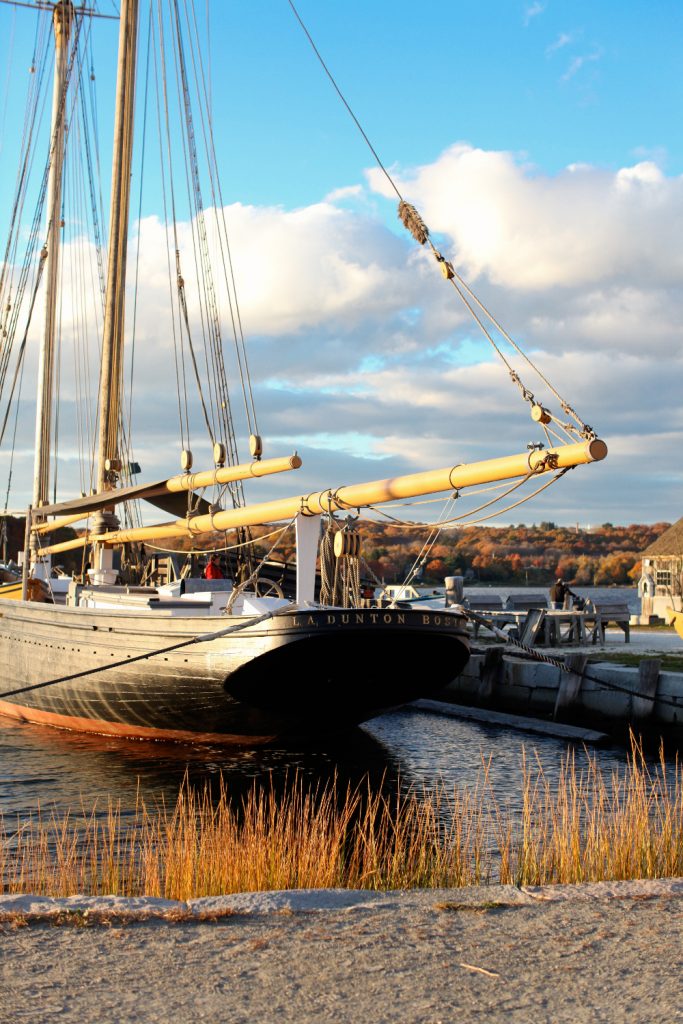Back in December 2022 we hauled the L. A. Dunton and blocked the vessel up near the entrance to the shipyard for the duration of

The L. A. Dunton which spans 123 feet, 3 inches over all, is one of the few remaining vessels of this type in the country. Designed by Thomas F. McManus, the L. A. Dunton was built by Arthur D. Story and launched from his well-known yard at Essex, Massachusetts, in 1921.
The vessel is now undergoing a multi-year restoration in the Henry B. du Pont Preservation Shipyard. We invite you to be a permanent part of keeping history alive by supporting the restoration of this important vessel.
Sailing schooners were forced from the Grand Banks off Newfoundland and Georges Bank outside of Cape Cod more than 50 years ago, despite the fact that their design made them the fastest and ablest fishing vessels in the world.
Built after auxiliary gasoline power had become common in schooners, the Dunton was probably the last large engine-less fishing schooner (a few later ones were built primarily for racing). The Dunton was used in the haddock and halibut fisheries, landing catches in Boston.
By 1923 the vessel was equipped with a 100 H.P. Fairbanks, Morse and Co. C-O engine, and when the Great Depression worsened, the vessel was sold to Newfoundland owners in 1934. For 30 years the Dunton was used as a fishing and freighting vessel, eventually being converted to a motor vessel with auxiliary sail. In this form the Dunton was acquired by Mystic Seaport Museum in 1963.
Soon after the Dunton’s arrival, restoration to the vessel’s original design was undertaken. Subsequent work has ensured that the structural integrity is maintained. Between 1974 and 1985, the engine was removed, the stern restored to the correct appearance, deck beams, deck planking and frames replaced, and topsides were replanked. This work was necessary to maintain the Dunton as an example of the finest type of American fishing schooner and a testimonial to the hard-working fishermen who manned the vessel. The L. A. Dunton was designated a National Historic Landmark vessel in 1993.
Restore the L. A. Dunton to sailing condition.
The L. A. Dunton has been deemed culturally significant and Mystic Seaport Museum is honored to be the steward of
this vessel.
The L. A. Dunton represents an essential element in the 350-year history of the New England fishing industry.
We invite you to be a permanent part of keeping history alive by supporting the restoration of this important vessel.
We need your help to ensure future generations can appreciate the maritime legacy that has shaped our nation. Mystic Seaport Museum is rooted in history but never stuck in the past. We continue to build our collections, mine them for salient and impactful stories, and present those stories to audiences of every sort.
Back in December 2022 we hauled the L. A. Dunton and blocked the vessel up near the entrance to the shipyard for the duration of

On the continental shelf, between the warm waters of the Gulf Stream and the cold flow of the Labrador Current, shallow plateaus called banks are fertile grounds for marine life. For more than 500 years, fishermen have come to the banks seeking the natural bounty of cod, haddock, halibut, and other edible fish. Sailing from the principal New England fishing ports of Gloucester and Boston, the L. A. Dunton worked all these waters, from Georges Bank 100 miles east of Cape Cod, to the Grand Bank of Newfoundland, 800 miles east-northeast of Gloucester.
When New England fishermen began to work shallow, rough Georges Bank in the 1830s, it was the most productive fishing bank in the North Atlantic. The L. A. Dunton usually fished these waters between Labor Day and Easter, catching haddock, cod, hake, cusk, pollock, and halibut to be sold fresh in Boston. By the end of the Dunton’s American career in the early 1930s, the effects of overfishing on Georges had been noticed, but the fishing effort increased. The net form of fishing represented by the Museum’s eastern-rig dragger Roann, practiced through the 1960s and 1970s by huge foreign fishing ships as well as US and Canadian vessels, depleted the most popular species. In 1994, most of Georges Bank was closed to fishing in hopes that the haddock, cod, and flounder populations would recover.
Monday–Thursday | 10:00 a.m.–4:00 p.m.
Thompson Exhibition Building and Collins Gallery open. Remaining campus closed.
Friday–Sunday | 10:00 a.m.–4:00 p.m.
North campus, exhibition galleries, and whaleship Charles W. Morgan open. Grounds close at 5:00 p.m.
South Entrance, Village, and Shipyard will reopen March 20. Ticket prices are reduced during this time.
More information here.
75 Greenmanville Ave
Mystic, CT 06355
860-572-0711